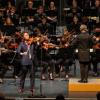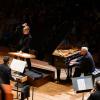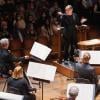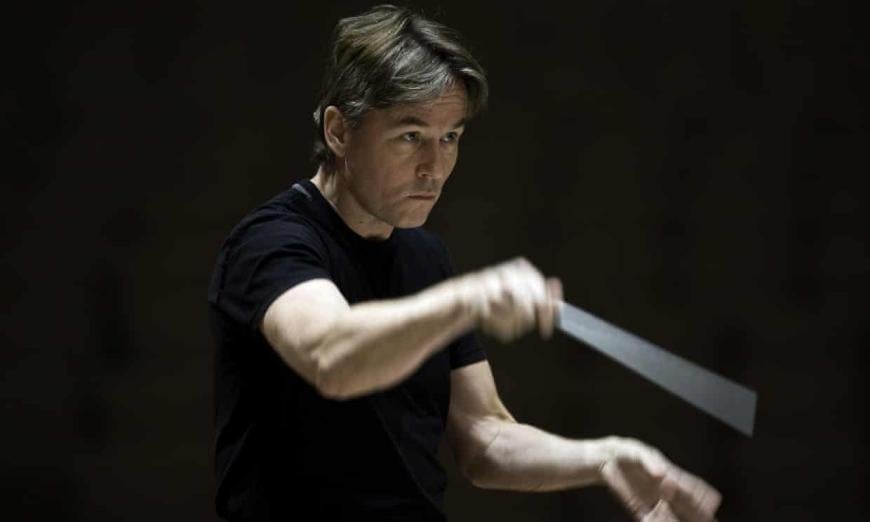
It’s getting repetitive to write this, but it’s hard to dispute: Sunday afternoon (Feb. 20) was another good day for the Los Angeles Philharmonic and its conductor laureate and prodigal son, Esa-Pekka Salonen.
Again, Salonen devised a program that was unusual, stimulating, interconnected, and newsworthy — one that played to his strengths and tastes. As was true the week before. As has been true the last several years whenever he sets foot in Walt Disney Concert Hall for his annual two weeks with his old band.
Each time this year, Salonen has come to town with a world premiere concerto. The previous week, it was Gabriella Smith’s vividly imaginative Breathing Forests for organ and orchestra, with its novel exploitations of string tremolos and col legno effects (hitting strings with the bow’s wooden rod) and massive clusters of acoustical instrumental sound that even this hall could barely contain. On Sunday, it was Iceland’s Daníel Bjarnason’s turn again to fulfill a Philharmonic commission with a multifaceted piano concerto that he calls FEAST.
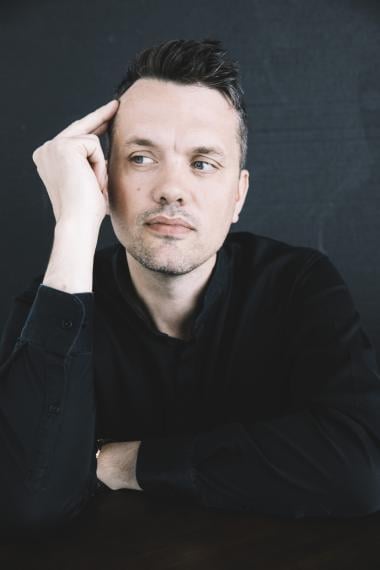
FEAST is another contribution to what is becoming a long line of Covid-era pieces born during forced isolation (another inspiration for the work was Edgar Allen Poe’s The Masque of the Red Death). That Bjarnason was thinking of the dark side during this time — the idea of a “dance of death” or Totentanz or memento mori — shouldn’t come as a surprise, nor should an inevitable contrary urge to “fully embrace life, knowing of death” (that’s what Shostakovich was thinking when writing his death-obsessed 14th Symphony).
What did come as a surprise was the opening of the work — a lot of rambunctious activity evoking paprika-spiked Bartók (more on that programming coup later) and not at all like the typical drones of distant landscapes that color so much Icelandic music. The latter would come soon enough with the first of several cadenzas for solo piano, and a haunting passage for gongs, timpani, and offstage bells played pianissimo.
The 23-minute-plus piece is divided into seven sections played continuously, the titles “Revellers,” “Visitor,” “Knell,” “Dance,” “Revelation,” “Danse Macabre,” and “Procession” triggering and reflecting the work’s constantly alternating moods. Bjarnason’s countryman Víkingur Ólafsson, whose marvelous touch and openness to fresh ideas has made him one of the piano world’s leading “it” men, firmly navigated the pounding angst, hushed contemplation, flourishes of old-fashioned barnstorming, and the quiet ending marked by pops and crackles from the percussion section.
Now as for Bartók, I don’t know if Salonen knew what he was getting from Bjarnason in advance, but the beginning of the Icelandic composer’s new piece sounded like a not-so-distant descendant of the Hungarian composer’s Music for Strings, Percussion, and Celesta, which was played before intermission. Moreover Bartók’s spicy, spiky masterpiece is an ideal vehicle for Salonen — appealing to his modernist sensibilities and cultivation of orchestral brilliance.
He took the first movement considerably slower than when he recorded it early in his tenure with the LA Phil (Sony, 1996), with greater warmth, tension, and unswerving focus on the line so that when the movement goes over the hump of the climax, the result was spine-tingling. The second movement had lots of lean-machine drive with sharp, jolting accents; the shimmering piano, harp, and celesta glissandos of the third movement and gusts of energy in the finale also passed the goosebump test. I’ve never heard this work done better in live performance.
The Sibelius Symphony No. 7 is, of course, not the only possible conclusion to a concert like this, but it would be difficult to find one that puts a more solid punctuation mark at the end. The Seventh is a miraculously concise summing up of Sibelius’s symphonic achievement, telescoping four somewhat distinct movements into a tightly-organized, 21-minute single movement. You can detect reminders, if not actual literal quotes, of all six of his previous numbered symphonies within its pages.
While Salonen didn’t do anything unconventional with the piece, he realized its stirring power, maintaining a solid line all the way up to the magnificent summit of the unofficial first movement with impeccable timing, doing the same in the grand passages of the work’s final minutes. The Phil rose to the occasion as they always do for Salonen. Thank goodness that San Francisco shares him with Los Angeles now and then.


